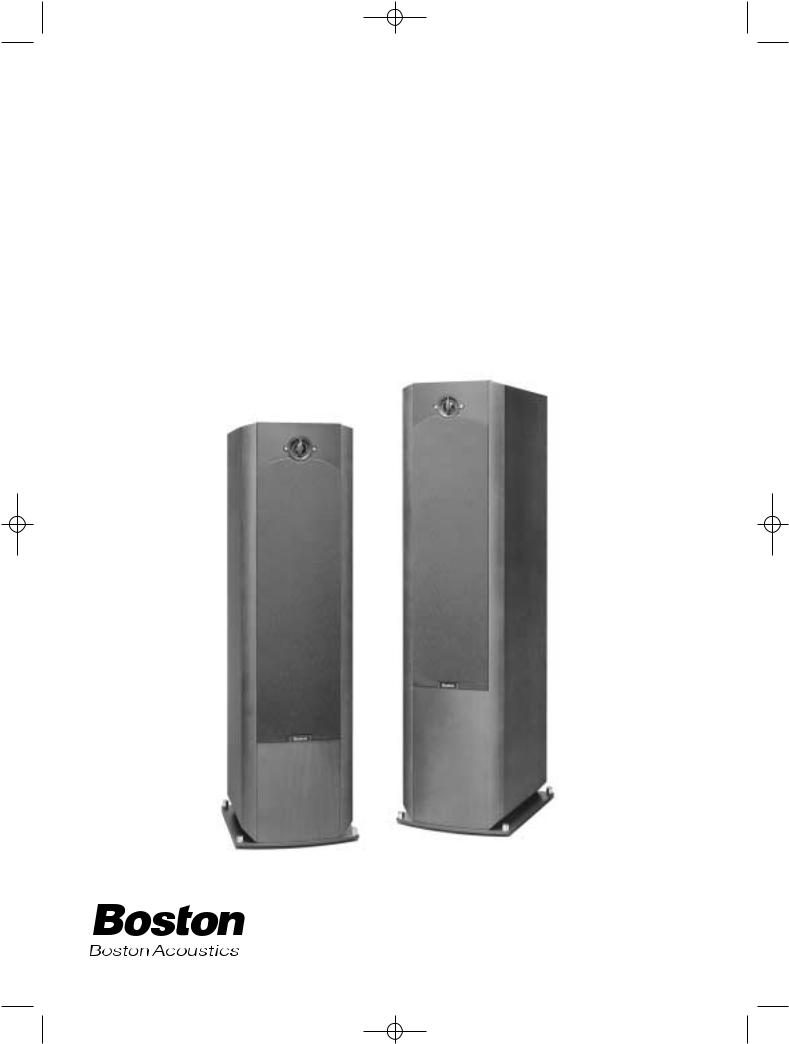Boston acoustics VR-M90, VR-M80 Manual

VRM80/90 manual v3 11/28/01 12:58 PM Page 1


 VR-M80
VR-M80
VR-M90
Reference Series
High Performance Floorstanding Speakers

VRM80/90 manual v3 11/28/01 12:58 PM Page 2
Specifications |
VR-M90 |
VR-M80 |
|
|
|
Frequency Response (±3dB) |
36–20,000Hz |
42–20,000Hz |
|
|
|
Recommended Amplifier Power |
50–350 watts |
50–250 watts |
|
|
|
Nominal Impedance |
8 ohms |
8 ohms |
|
|
|
Sensitivity [1 watt (2.83v) at 1m] |
89dB |
90dB |
|
|
|
Bass Units |
2 x 61⁄2" (165mm) DCD copolymer |
2 x 51⁄4" (135mm) DCD copolymer |
Midrange |
31⁄2" (89mm) |
|
Tweeter |
1" (25mm) black anodized |
1" (25mm) black anodized |
|
aluminum dome with AMD |
aluminum dome with AMD |
|
|
|
Crossover Frequency |
350, 2500Hz |
2500Hz |
|
|
|
Dimensions (HxWxD) |
371⁄4 x 91⁄4 x 14" (946 x 235 x 357mm) |
333⁄4 x 91⁄4 x 12" (857 x 235 x 305mm) |
Weight |
65 lbs. (29.5kg) |
58 lbs. (26.3kg) |
|
|
|
Finish |
Cherry wood veneer with |
Cherry wood veneer with |
|
cast aluminum baseplate |
cast aluminum baseplate |
Description
The VR-M80 and VR-M90 are monitor-quality floorstanding speakers designed to deliver accurate, natural reproduction, with an elegant appearance. All the exposed surfaces of the VRM-80 and VR-M90 are clad in a hand-rubbed cherry hardwood veneer. Extra thick, 11⁄8-inch MDF is used for the cabinet side walls, to maximize cabinet rigidity and minimize coloration. A vertical brace runs the entire height of both cabinets, to further reduce unwanted cabinet resonance. The rearmounted vent is smoothly flared at both ends to reduce port turbulence, and both speakers feature dual gold-plated binding posts, allowing bi-wiring or bi-amping with virtually any cable.
Special care has been taken to optimize the speakers’ components for maximum performance: The bass units utilize diecast aluminum baskets that keep the critical moving parts in precise alignment for exceptionally accurate response. The cast baskets also conduct heat away from the voice coil, increasing power handling and maximizing output. The woofer cones and surround geometry were designed and optimized with Boston’s Finite Element Analysis (FEA) computer modeling technology, for strong bass and smooth midrange. High frequencies are handled by Boston’s patented 1-inch (25mm) aluminum tweeter with Amplitude Modification Device™ (AMD). This remarkable driver produces an extremely smooth, flat response well beyond the audible range. A die-cast, multi-finned aluminum heatsink attached to the tweeter’s backplate dissipates heat quickly and efficiently, assuring cool, trouble-free operation, even at very high power levels. All the drive units are designed at Boston’s Peabody, Massachusetts facility using state-of-the-art computer-design programs, and are built on Boston’s proprietary production lines to an incredible ±1dB—perhaps the industry’s tightest tolerance. Both systems feature MagnaGuard® magnetic shielding for compatibility with home theater systems. A new 31⁄2-inch (89mm) midrange driver is being used for the first time in the VR-M90. Its cast-aluminum basket has an integrated yoke for its neodymium magnet, assuring extraordinary heat dissipation characteristics. The injection molded polypropylene cone is molded with the surround, eliminating a glue joint. This reduces the mass of the moving parts of the driver, and improves power handling and high frequency performance.
The crossovers for the VR-M80 and VR-M90 have been enhanced to maximize sound quality and improve power handling. An extra-thick glass epoxy printed circuit board supports thicker traces. The connecting wires are 16 gauge, and all connections are gold plated.
The cast aluminum base plate provides additional coupling of the speaker to the floor, while enhancing its handsome aesthetic. Each speaker is furnished with height adjustable, rubber capped feet as well as two lengths of carpet spikes. Also included are gold-plated hex caps, for a more elegant appearance.
2

VRM80/90 manual v3 11/28/01 12:58 PM Page 3
How to Connect Your Speakers
Correctly wiring your speakers is important for achieving the best sound quality. Wiring should take just a few minutes, but it’s important to do it carefully, since incorrect wiring (such as reversed connections) can result in a poor soundstage and poor bass.
We recommend 16-gauge wire or thicker for runs up to 15 feet (4.5m), and 14-gauge wire or thicker for longer runs. (see Speaker Cable section on page 5). Separate the first few inches of the wire conductors. Strip off 1⁄2" (12mm) of insulation from the ends of each speaker wire to expose the two conductors and tightly twist the wire strands.
WARNING: To prevent electrical shock hazard, always switch off the amplifier or receiver when making connections to the speaker.
When making all connections, be sure to connect the + (red) on the speaker to the + (red) on the amplifier, and the
– (black) on the speaker to the – (black) on the amplifier.
IMPORTANT: Typically, one side of the wire is smooth. Connect this side to the – (black) connection. The other side has a rib or stripe. Connect this to the
+ (red) connection.
Using the five-way binding posts: The binding posts permit easy connection to banana plugs, spade lugs, and bare wire.
Insert the wire in the hole and tighten.
Checking the Speaker Connections
It is important that your speakers are hooked up with similar polarity or “in phase.” A simple listening test will tell you if your speakers are connected properly. Place the speakers face to face, as closely together as possible. While listening to music with your amplifier set to MONO, reverse the connections at one speaker only. You’ll hear a dramatic change in sound. The connection that yields the fuller bass and louder sound is correct.
3
